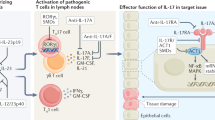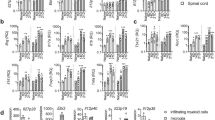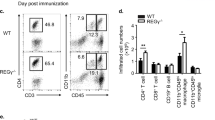Abstract
Interleukin 27 (IL-27) was first characterized as a proinflammatory cytokine with T helper type 1–inducing activity. However, subsequent work has demonstrated that mice deficient in IL-27 receptor (IL-27Rα) show exacerbated inflammatory responses to a variety of challenges, suggesting that IL-27 has important immunoregulatory functions in vivo. Here we demonstrate that IL-27Rα-deficient mice were hypersusceptible to experimental autoimmune encephalomyelitis and generated more IL-17-producing T helper cells. IL-27 acted directly on effector T cells to suppress the development of IL-17-producing T helper cells mediated by IL-6 and transforming growth factor-β. This suppressive activity was dependent on the transcription factor STAT1 and was independent of interferon-γ. Finally, IL-27 suppressed IL-6-mediated T cell proliferation. These data provide a mechanistic explanation for the IL-27-mediated immune suppression noted in several in vivo models of inflammation.
This is a preview of subscription content, access via your institution
Access options
Subscribe to this journal
Receive 12 print issues and online access
$209.00 per year
only $17.42 per issue
Buy this article
- Purchase on Springer Link
- Instant access to full article PDF
Prices may be subject to local taxes which are calculated during checkout







Similar content being viewed by others
References
Pflanz, S. et al. IL-27, a heterodimeric cytokine composed of EBI3 and p28 protein, induces proliferation of naive CD4+ T cells. Immunity 16, 779–790 (2002).
Hibbert, L., Pflanz, S., De Waal Malefyt, R. & Kastelein, R.A. IL-27 and IFN-α signal via STAT1 and STAT3 and induce T-bet and IL-12Rβ2 in naive T cells. J. Interferon Cytokine Res. 23, 513–522 (2003).
Lucas, S., Ghilardi, N., Li, J. & de Sauvage, F.J. IL-27 regulates IL-12 responsiveness of naive CD4+ T cells through STAT1-dependent and -independent mechanisms. Proc. Natl. Acad. Sci. USA 100, 15047–15052 (2003).
Takeda, A. et al. Cutting edge: role of IL-27/WSX-1 signaling for induction of T-bet through activation of STAT1 during initial Th1 commitment. J. Immunol. 170, 4886–4890 (2003).
Chen, Q. et al. Development of Th1-type immune responses requires the type I cytokine receptor TCCR. Nature 407, 916–920 (2000).
Pflanz, S. et al. WSX-1 and glycoprotein 130 constitute a signal-transducing receptor for IL-27. J. Immunol. 172, 2225–2231 (2004).
Sprecher, C.A. et al. Cloning and characterization of a novel class I cytokine receptor. Biochem. Biophys. Res. Commun. 246, 82–90 (1998).
Holscher, C. et al. The IL-27 receptor chain WSX-1 differentially regulates antibacterial immunity and survival during experimental tuberculosis. J. Immunol. 174, 3534–3544 (2005).
Pearl, J.E. et al. IL-27 signaling compromises control of bacterial growth in mycobacteria-infected mice. J. Immunol. 173, 7490–7496 (2004).
Villarino, A. et al. The IL-27R (WSX-1) is required to suppress T cell hyperactivity during infection. Immunity 19, 645–655 (2003).
Yoshida, H. et al. WSX-1 is required for the initiation of Th1 responses and resistance to L. major infection. Immunity 15, 569–578 (2001).
Artis, D. et al. The IL-27 receptor (WSX-1) is an inhibitor of innate and adaptive elements of type 2 immunity. J. Immunol. 173, 5626–5634 (2004).
Hamano, S. et al. WSX-1 is required for resistance to Trypanosoma cruzi infection by regulation of proinflammatory cytokine production. Immunity 19, 657–667 (2003).
Miyazaki, Y. et al. Exacerbation of experimental allergic asthma by augmented Th2 responses in WSX-1-deficient mice. J. Immunol. 175, 2401–2407 (2005).
Yamanaka, A. et al. Hyperproduction of proinflammatory cytokines by WSX-1-deficient NKT cells in concanavalin A-induced hepatitis. J. Immunol. 172, 3590–3596 (2004).
Park, H. et al. A distinct lineage of CD4 T cells regulates tissue inflammation by producing interleukin 17. Nat. Immunol. 6, 1133–1141 (2005).
McKenzie, B.S., Kastelein, R.A. & Cua, D.J. Understanding the IL-23-IL-17 immune pathway. Trends Immunol. 27, 17–23 (2006).
Langrish, C.L. et al. IL-23 drives a pathogenic T cell population that induces autoimmune inflammation. J. Exp. Med. 201, 233–240 (2005).
Harrington, L.E. et al. Interleukin 17–producing CD4+ effector T cells develop via a lineage distinct from the T helper type 1 and 2 lineages. Nat. Immunol. 6, 1123–1132 (2005).
Infante-Duarte, C., Horton, H.F., Byrne, M.C. & Kamradt, T. Microbial lipopeptides induce the production of IL-17 in Th cells. J. Immunol. 165, 6107–6115 (2000).
Aggarwal, S., Ghilardi, N., Xie, M.H., de Sauvage, F.J. & Gurney, A.L. Interleukin 23 promotes a distinct CD4 T cell activation state characterized by the production of interleukin 17. J. Biol. Chem. 278, 1910–1914 (2003).
Cua, D.J. et al. Interleukin-23 rather than interleukin-12 is the critical cytokine for autoimmune inflammation of the brain. Nature 421, 744–748 (2003).
Murphy, C.A. et al. Divergent pro- and antiinflammatory roles for IL-23 and IL-12 in joint autoimmune inflammation. J. Exp. Med. 198, 1951–1957 (2003).
Veldhoen, M., Hocking, R.J., Atkins, C.J., Locksley, R.M. & Stockinger, B. TGFβ in the context of an inflammatory cytokine milieu supports de novo differentiation of IL-17-producing T cells. Immunity 24, 179–189 (2006).
Bettelli, E. et al. Reciprocal developmental pathways for the generation of pathogenic effector TH17 and regulatory T cells. Nature 441, 235–238 (2006).
Mangan, P.R. et al. Transforming growth factor-β induces development of the TH17 lineage. Nature 441, 231–234 (2006).
Villarino, A.V. et al. IL-27 limits IL-2 production during Th1 differentiation. J. Immunol. 176, 237–247 (2006).
Owaki, T. et al. IL-27 suppresses CD28-mediated IL-2 production through suppressor of cytokine signaling 3. J. Immunol. 176, 2773–2780 (2006).
Bettelli, E. et al. Loss of T-bet, but not STAT1, prevents the development of experimental autoimmune encephalomyelitis. J. Exp. Med. 200, 79–87 (2004).
Pasare, C. & Medzhitov, R. Toll pathway-dependent blockade of CD4+CD25+ T cell-mediated suppression by dendritic cells. Science 299, 1033–1036 (2003).
Kolls, J.K. & Linden, A. Interleukin-17 family members and inflammation. Immunity 21, 467–476 (2004).
Sergejeva, S., Ivanov, S., Lotvall, J. & Linden, A. Interleukin-17 as a recruitment and survival factor for airway macrophages in allergic airway inflammation. Am. J. Respir. Cell Mol. Biol. 33, 248–253 (2005).
McQualter, J.L. et al. Granulocyte macrophage colony-stimulating factor: a new putative therapeutic target in multiple sclerosis. J. Exp. Med. 194, 873–882 (2001).
Samoilova, E.B., Horton, J.L., Hilliard, B., Liu, T.S. & Chen, Y. IL-6-deficient mice are resistant to experimental autoimmune encephalomyelitis: roles of IL-6 in the activation and differentiation of autoreactive T cells. J. Immunol. 161, 6480–6486 (1998).
Cho, M.L. et al. STAT3 and NF-κB signal pathway is required for IL-23-mediated IL-17 production in spontaneous arthritis animal model IL-1 receptor antagonist-deficient mice. J. Immunol. 176, 5652–5661 (2006).
Chen, Z. et al. Selective regulatory function of SOCS3 in the formation of IL-17-secreting T cells. Proc. Natl. Acad. Sci. USA 103, 8137–8142 (2006).
Schimpl, A. et al. IL-2 and autoimmune disease. Cytokine Growth Factor Rev. 13, 369–378 (2002).
Honda, K. et al. T helper 1-inducing property of IL-27/WSX-1 signaling is required for the induction of experimental colitis. Inflamm. Bowel Dis. 11, 1044–1052 (2005).
Jebbari, H., Roberts, C.W., Ferguson, D.J., Bluethmann, H. & Alexander, J. A protective role for IL-6 during early infection with Toxoplasma gondii. Parasite Immunol. 20, 231–239 (1998).
Suzuki, Y. et al. Impaired resistance to the development of toxoplasmic encephalitis in interleukin-6-deficient mice. Infect. Immun. 65, 2339–2345 (1997).
Gao, W. & Pereira, M.A. Interleukin-6 is required for parasite specific response and host resistance to Trypanosoma cruzi. Int. J. Parasitol. 32, 167–170 (2002).
Kelly, M.N. et al. Interleukin-17/interleukin-17 receptor-mediated signaling is important for generation of an optimal polymorphonuclear response against Toxoplasma gondii infection. Infect. Immun. 73, 617–621 (2005).
Doganci, A., Sauer, K., Karwot, R. & Finotto, S. Pathological role of IL-6 in the experimental allergic bronchial asthma in mice. Clin. Rev. Allergy Immunol. 28, 257–270 (2005).
Sedgwick, J.D. et al. Isolation and direct characterization of resident microglial cells from the normal and inflamed central nervous system. Proc. Natl. Acad. Sci. USA 88, 7438–7442 (1991).
Acknowledgements
We thank W. Ouyang and B. Irving for critical reading of the manuscript; N. Pal and the Genentech Histology Laboratory for processing and staining of histological specimens; and R. Scott and S. Liu for animal husbandry.
Author information
Authors and Affiliations
Corresponding author
Ethics declarations
Competing interests
The authors are employed or were previously employed by Genentech and may or may not benefit financially from the publication of this paper.
Supplementary information
Supplementary Fig. 1
EAE in Il27ra−/− mice is ameliorated by treatment with a neutralizing anti-IL-17A antibody. (PDF 42 kb)
Supplementary Fig. 2
Quantitative PCR analysis of IL23r expression. (PDF 55 kb)
Supplementary Fig. 3
Additive effect of IFN-γ and IL-27 in protection against EAE. (PDF 49 kb)
Supplementary Fig. 4
IL-27 induced IL-17 in STAT-1-deficient cells is independent of APC. (PDF 65 kb)
Supplementary Fig. 5
Natural regulatory T cell number is unchanged IL-27r−/− mice. (PDF 131 kb)
Supplementary Table 1
Primer sequences. (PDF 7 kb)
Rights and permissions
About this article
Cite this article
Batten, M., Li, J., Yi, S. et al. Interleukin 27 limits autoimmune encephalomyelitis by suppressing the development of interleukin 17–producing T cells. Nat Immunol 7, 929–936 (2006). https://doi.org/10.1038/ni1375
Received:
Accepted:
Published:
Issue Date:
DOI: https://doi.org/10.1038/ni1375
This article is cited by
-
Pro- and anti-inflammatory bioactive lipids imbalance contributes to the pathobiology of autoimmune diseases
European Journal of Clinical Nutrition (2023)
-
Selective IL-27 production by intestinal regulatory T cells permits gut-specific regulation of TH17 cell immunity
Nature Immunology (2023)
-
Cell type specific IL-27p28 (IL-30) deletion in mice uncovers an unexpected regulatory function of IL-30 in autoimmune inflammation
Scientific Reports (2023)
-
Therapeutic modulation of JAK-STAT, mTOR, and PPAR-γ signaling in neurological dysfunctions
Journal of Molecular Medicine (2023)
-
JAKs and STATs from a Clinical Perspective: Loss-of-Function Mutations, Gain-of-Function Mutations, and Their Multidimensional Consequences
Journal of Clinical Immunology (2023)



